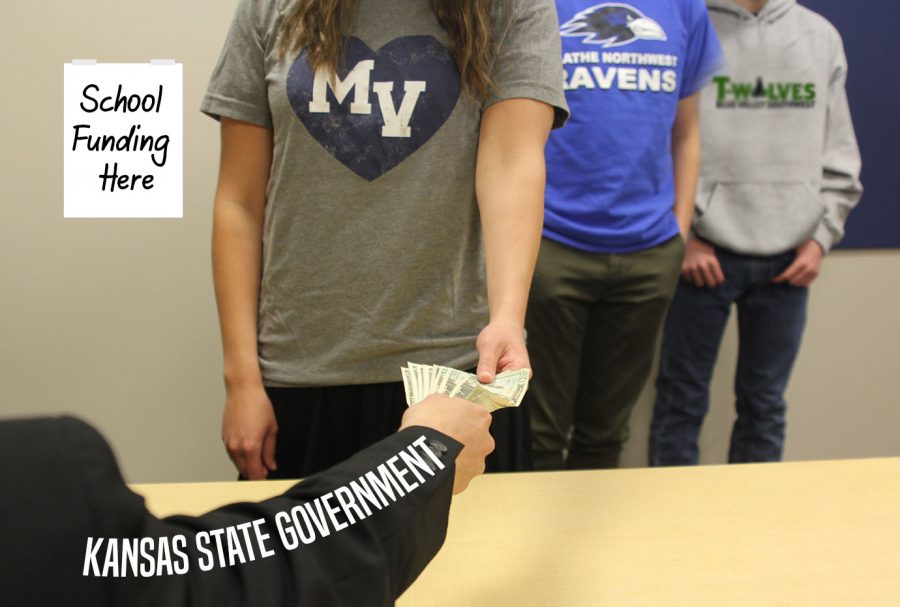Plans introduced to address lack of public education funding incite discussion, negotiation
The state Supreme Court’s ruling declares the lack of funding unconstitutional
Kansas schools to receive more funding from state after experiencing lack thereof in past years.
April 7, 2017
With the recent ruling by the state Supreme Court that unanimously declared the lack of funding towards public education unconstitutional, teachers and administrators alike are discussing the best way to solve the funding issue.
Several plans have been recently introduced to address this issue, including a plan called the Chairman’s Plan, which would distribute money based on enrollment numbers, called “foundation aid,” much like the 1992 formula that was disassembled under Brownback. Unlike the 1992 formula, however, the Chairman’s Plan would rely heavily on property taxes. Superintendent Frank Harwood estimates that, if passed, USD232 would receive about $2 million.
Another plan introduced is House Bill 2270, which would steadily increase funding over the next four years. Again, foundation aid would be reinstated, and additional aid would be distributed depending on the amount of at-risk students and career technical education classes, which are called weightings. This bill is closest to the current plan in plan, and Harwood speculates that considering the June 30 deadline, this is most likely to pass.
In contrast to these bills, which are currently being debated in Topeka, superintendent Jim Hinson of the Shawnee Mission School District has introduced a plan of his own, which would have higher based state aid per student and would get rid of almost all weightings.
“The idea is that if you get the money in the based state aid, you don’t need the weightings because you are now already getting the dollars,” Harwood said. “It’s just a different philosophy in how you distribute.”
English teacher Kristen Crosbie believes that while a plan like Hinson’s can be beneficial for some school districts, a focus on property taxes has already proven to be ineffectual for De Soto schools.
“We have less business in this area than the Shawnee Mission district,” Crosbie said, “so they can afford higher salaries and probably more books and other amenities.”
Social studies teacher Angie Dalbello is one of two building representatives for the De Soto Teachers Association, along with social studies teacher Jeff Wieland. The DTA is responsible for initiating discussion and negotiation between district employees on topics such as salaries, resources and internal conflicts. Dalbello was happy to hear about the Court’s ruling, and hopes it encourages change within the state.
“I see that as a huge victory for public education,” Dalbello said, “and I agree with it.”
Likewise, junior Tom Colling has noticed that extracurriculars tend to suffer when the school district is underfunded.
“Some of the smaller, newer clubs are not getting [as much] funding,” Colling said, “so we have to pay for most of our stuff ourselves, whereas other schools get that support.”
For English teacher Kristen Crosbie, no matter what plan is passed, the biggest issue is the government’s attitude toward education in general.
“I feel like over the past few years … [public education] has become a nonpriority,” Crosbie said. “We were supposed to get new English books next year, went to several meetings for them, and we can’t afford to get them now. Our classrooms are full and we haven’t gotten raises to speak of: little ones, but not much.”
Dalbello says that if the state government does end up giving more money for education, it should be budgeted towards salaries that would allow schools to hire more teachers.
“I’ve been in this district since 1999 and the class sizes just continue to get bigger,” Dalbello said. “Maybe that’s two or three kids more per section of a class, and that doesn’t sound like a lot, but when you’re at 29 kids instead of 25, that really can change the dynamics of the classroom. It’s just harder to manage when you have more kids, more papers to grade and more parents to communicate with.”
Colling thinks that above all, the ethical concerns raised by a lack of funding should be addressed.
“I believe that education is really important for the development of our futures,” Colling said. “Especially being high school students, it’s more relevant than ever to keep public school funding [well supported] to make sure we’re getting quality education.”
Harwood thinks that with school funding up in the air, it is difficult to make decisions for next year.
“We’ve done enrollment projections for each building,” Harwood said, “so they need to do staffing, and we also need to do negotiations with teachers … and we still have no idea how much money we’re going to have.”











